The Deep South: Asheville to Memphis
- Aaron Schorr
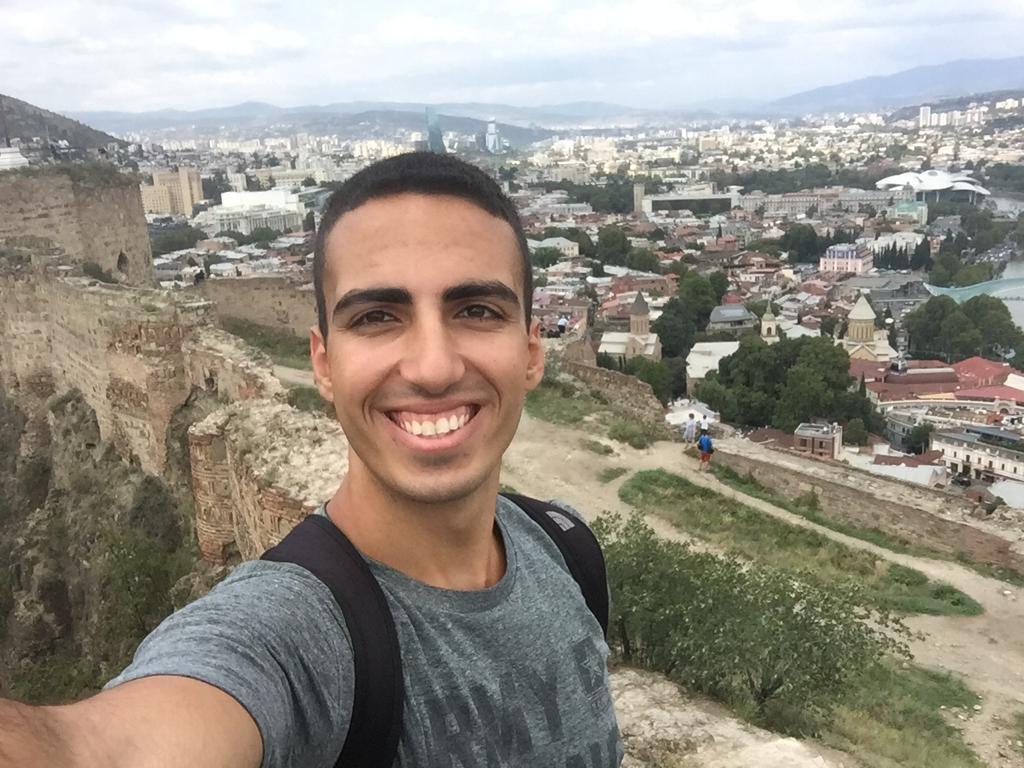
- Jan 14, 2021
- 14 min read
We stopped to charge in the outskirts of Asheville and passed the time in an outlet store, which had more Hawaiian shirts and shoes than I was comfortable with, then headed west on I-40 towards the Tennessee state line. Following the Pigeon River, the highway takes almost 30 miles to cross the mountains dividing the states, which are called the Great Smokies west of the border. We were precisely at the snow line, so every time the highway gained some elevation we’d find ourselves in picturesque snowy mountains which would be replaced by brown forests as soon as we descended again.

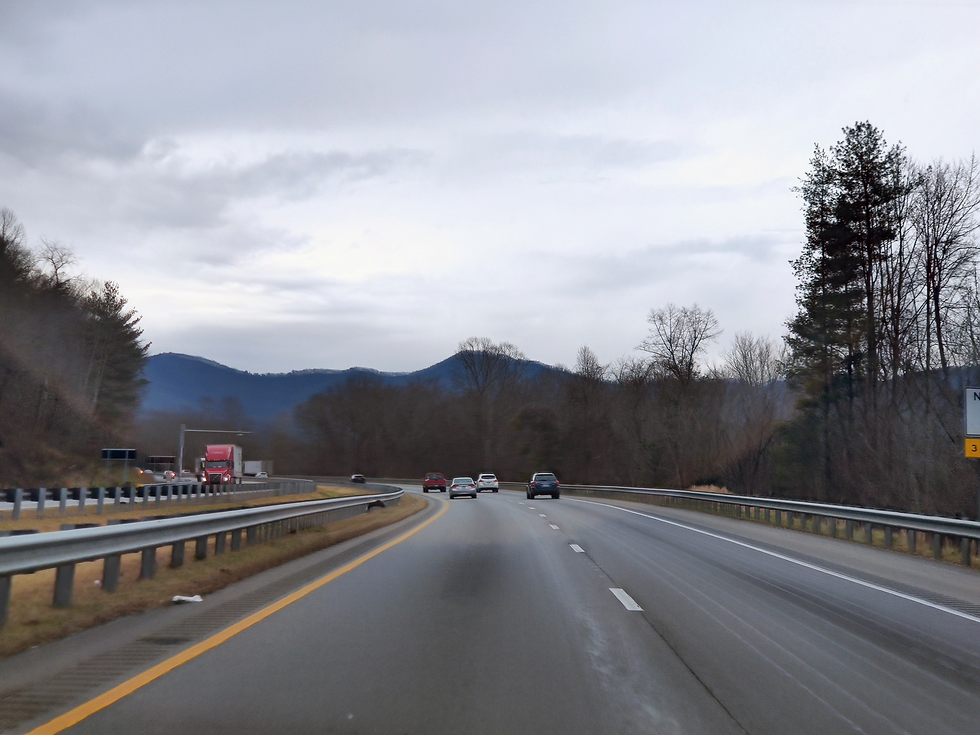
The scenery lost much of its ruggedness in Tennessee, the steep mountains petering out into the famous hill country of the Volunteer State. Passing a rainbow-colored 18-wheeler with the words “LGBT TRUCKERS” stenciled on it, our first stop was Great Smoky Knife Works, the self-styled “largest knife shop in the world”.

The place was the size of a stadium, with room after room of knives, guns, and everything in between. Descending the stairs wrapped around an indoor waterfall and moving past the moving display of forest animals performing a concert, the downstairs was even more outlandish. Glass cabinets held everything from Civil War memorabilia to purpoted dinosaur skeletons, with one memorable one dedicated to Nazi iconography and mementos. Judging by the extensive kid’s department, we were definitely the least-armed people in the area. The only females in the entire store? Working in the kitchen department.
We arrived in Knoxville, a city seemingly composed of one endless highway interchange, and checked into our hotel, which claimed to be downtown but had a very generous interpretation of that term. We were greeted by a shirtless man in the parking lot, clearly unfazed by the temperature in the high 30s, and the only person wearing a mask was the receptionist. We vowed to never return to a Red Roof Inn again.
The cold weather and an ongoing game played by the University of Tennessee’s basketball team meant the actual downtown was rather deserted, but the Tesla suprecharger led us to a grill on the banks of the Tennessee River that was quite good and had portion sizes large enough to nearly knock us all out. The added benefit was that the place was called Calhoun’s, which was also the name of my college at Yale before the former vice president’s racism was deemed too much and the name was finally changed in 2017. After dinner, we visited the largest structure in town, the 102,455-seat Neyland Stadium, home of the Tennessee Vols and fifth-largest stadium in the U.S. Without a crowd, it actually didn’t look that big, but still put every other stadium I had seen to shame.

Tennessee: The Nuclear State?
We happily left our hotel in Knoxville and made the brief trip to nearby Oak Ridge. The town was mere fields before World War II, when the Army chose it as the perfect location for the production facilities of the Manhattan Project. An entire city sprung up out of nothing, housing some of America’s greatest scientific minds as they worked to create the first nuclear weapons in secrecy. Today, it has the same strip malls as any other Southern town, but the Oak Ridge National Laboratory still carries out experimental physics research and a secretive government facility not far from town still produces nuclear material for military purposes.
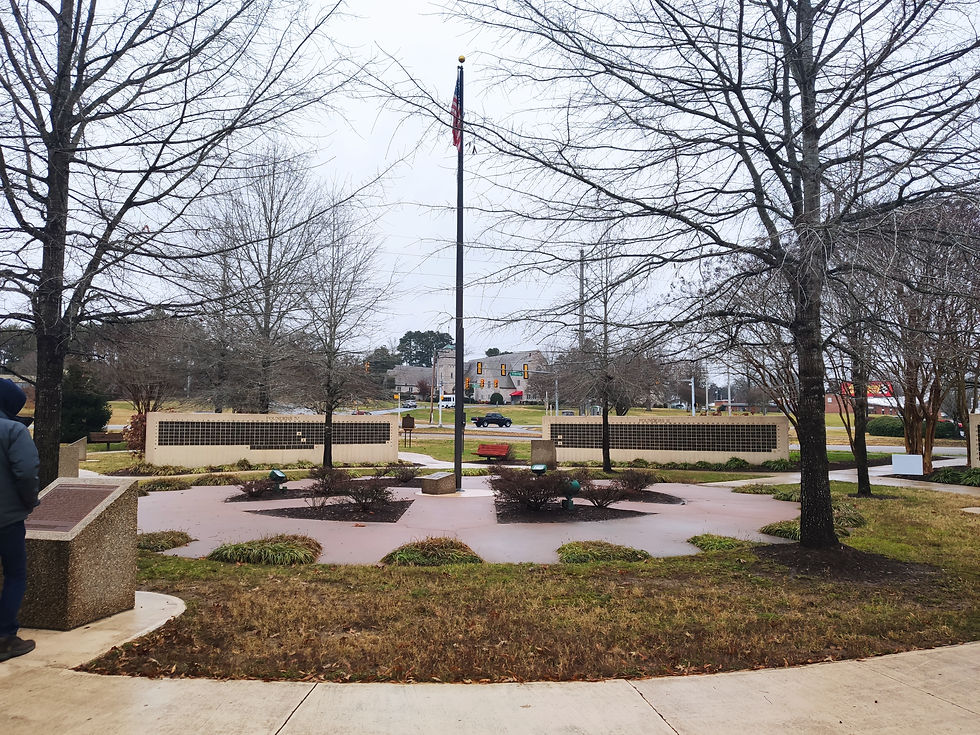
The museum dedicated to the Manhattan Project was closed for public health reasons, but a park downtown has a memorial walk with plaques detailing the town’s wartime history and an “International Peace Bell”, 750 pounds of copper cast in Japan and engraved with Japanese scenes of nature and messages of peace. Americans donated nearly $1 million to construct the bell in the 1980s as a sign of reconciliation between the U.S. and Japan, and the signs nearby explain off-handedly (certianly not apologetically) that the terrible destruction wrought on Japanese civilians by weapons created in this town in East Tennessee was necessary to avoid greater bloodshed. It was all incredibly American.
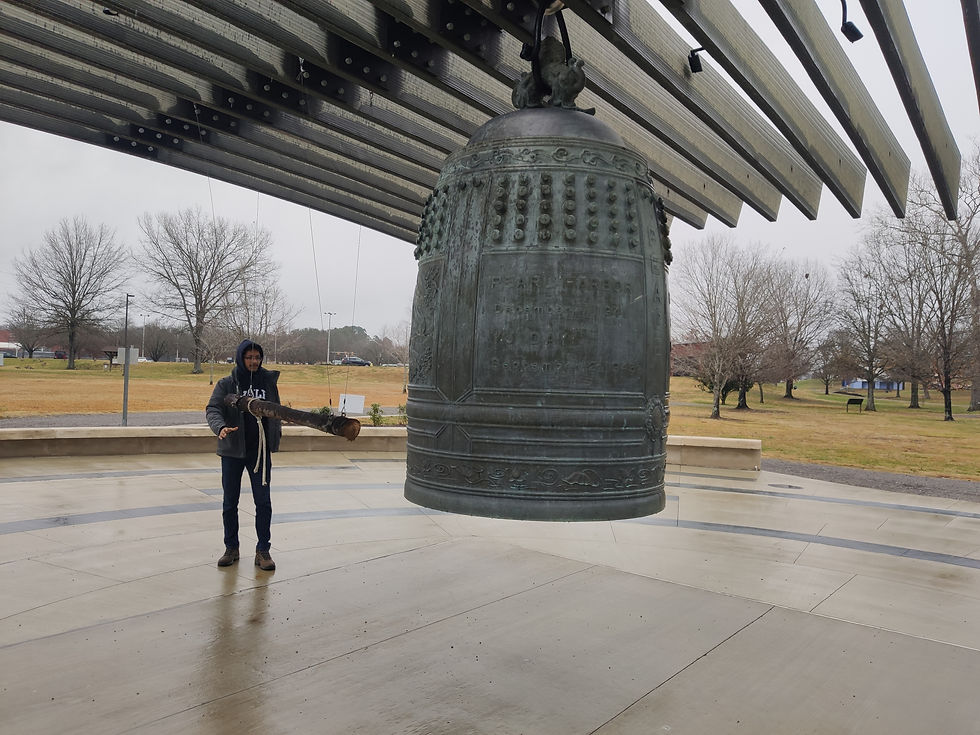

We continued west through endless rolling hills, passing above and below the snowline and crossing the Caney Fork River several times as we did so. Every place name around us seemed to end with “-ville”, from Charlottesville, Asheville, and Knoxville we had already visited, to Cookeville, Crossville, and Gordonsville we passed through on our way west. We departed the interstate for a state route, taking us through small, ramshackle towns seemingly rotting into the dreary landscape as they waited to see if they would be absorbed by the ever-growing strip malls spreading like an invasive growth along the main roads.
The blight reached a crescendo as we approached the town of Hartsville. Suddenly, a 400-foot tall nuclear cooling tower rose out of the valley floor, visible from miles away as we approached it. This was intended to be the Tennessee Valley Authority’s Hartsville plant, cancelled in 1984 after eight years of construction, incurring over $400 million in construction costs and widespread local resistance. The episode became a case study for enviromental activism and a symbol of rural Southerners resisting external pressure to change their ways of life (read this for context). Today, the site hosts a privately-operated prison and a small industrial park almost hidden by the abandoned control facilities, which make it seem even more dystopian than it already is on its own.
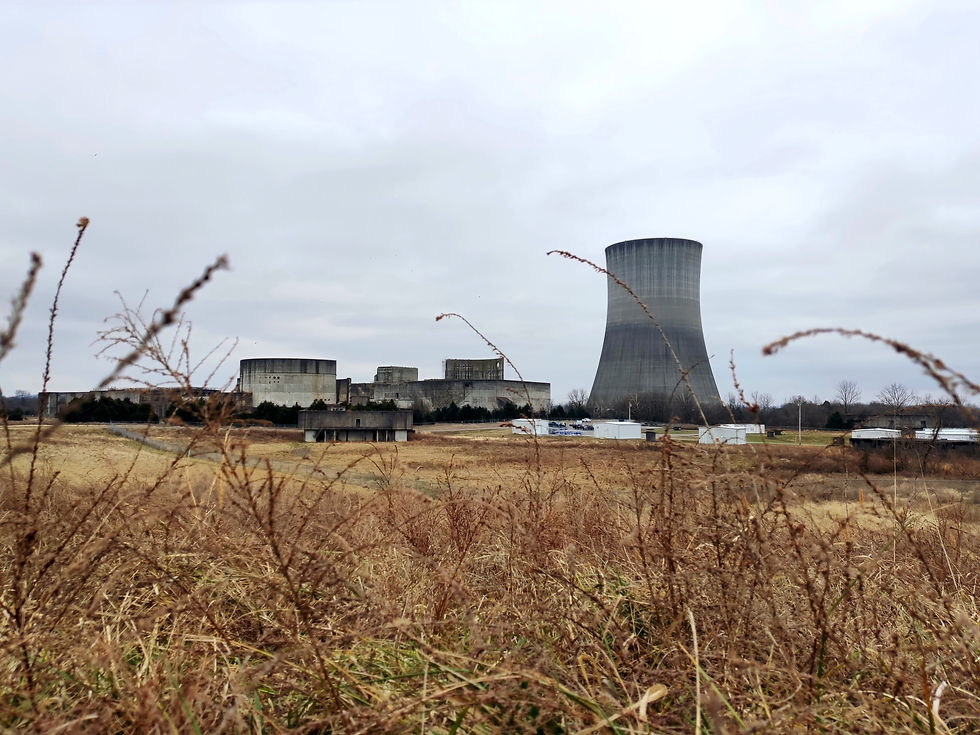
We disembarked on a small rise several hundred feet from the cooling tower to take pictures amidst a family of deer. From the research I did online, it seemed like the place was fairly regularly visited, at least as far as abandoned nuclear power plants go, but apparently we were an unusual sight. A man pulled up in a pickup truck and asked us in a thick drawl what we were doing.
“Taking pictures.”
“Of what?”
“The power plant.”
“Strange thing to be takin’ pictures of, ain’t it?”
I said we liked strange. He furrowed his brow and drove into the industrial park, apparently convinced we weren’t a threat. On second thought, I understood why a group of guys taking pictures with a telescopic lens near a prison might be suspicious, but a Tesla really wouldn’t be appropriate with the near universal stares it attracted.
We made a brief foray into Kentucky to visit the Kentucky Downs racetrack, located just over the state line. It was cold and windy, but there was something cool about being on an empty horse racetrack (plus Jake wanted to get his 35th state). Another hour on a truck-filled highway brought us to Nashville, which we had been excited about for a while.
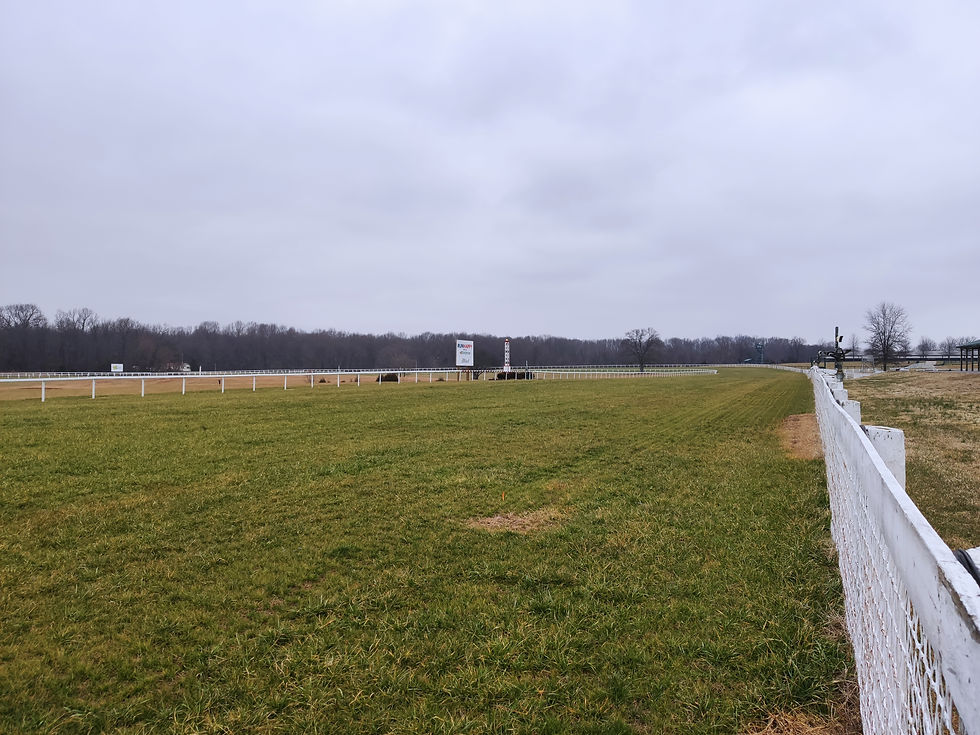
Nashville: Honky Tonks Galore
It was still light out when we arrived, so we went for a walk in the Gulch, a trendy neighborhood near our hotel. The place seemed near the end of its arc of gentrification, with plenty of manicured graffiti murals serving as Instagram photoshoot backdrops, nice hotels, and ethnic restaurants.
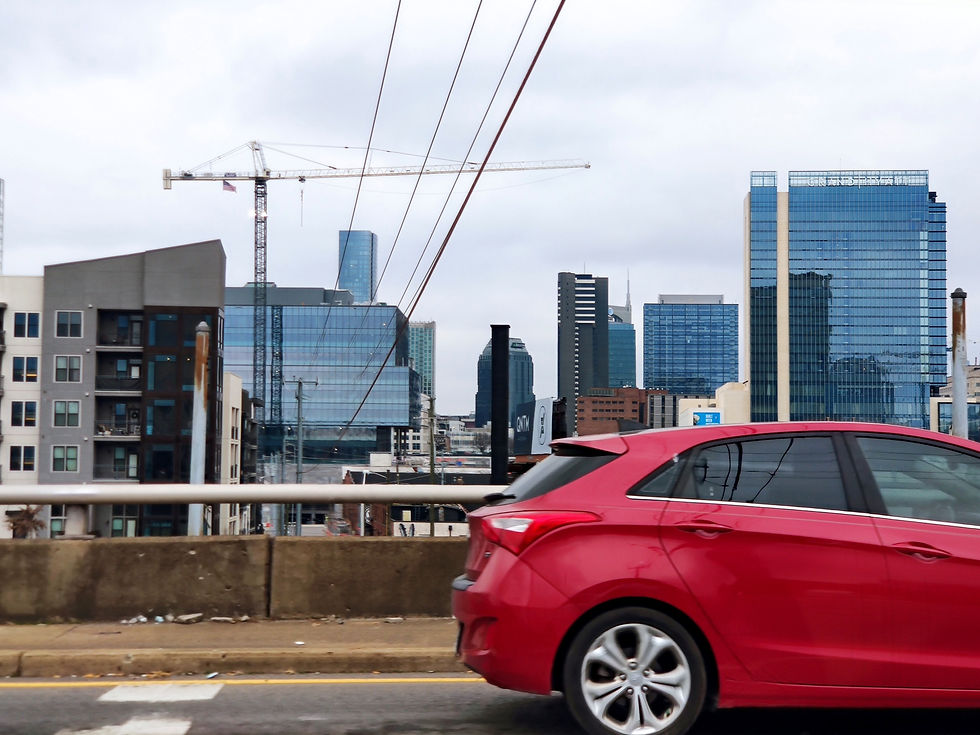
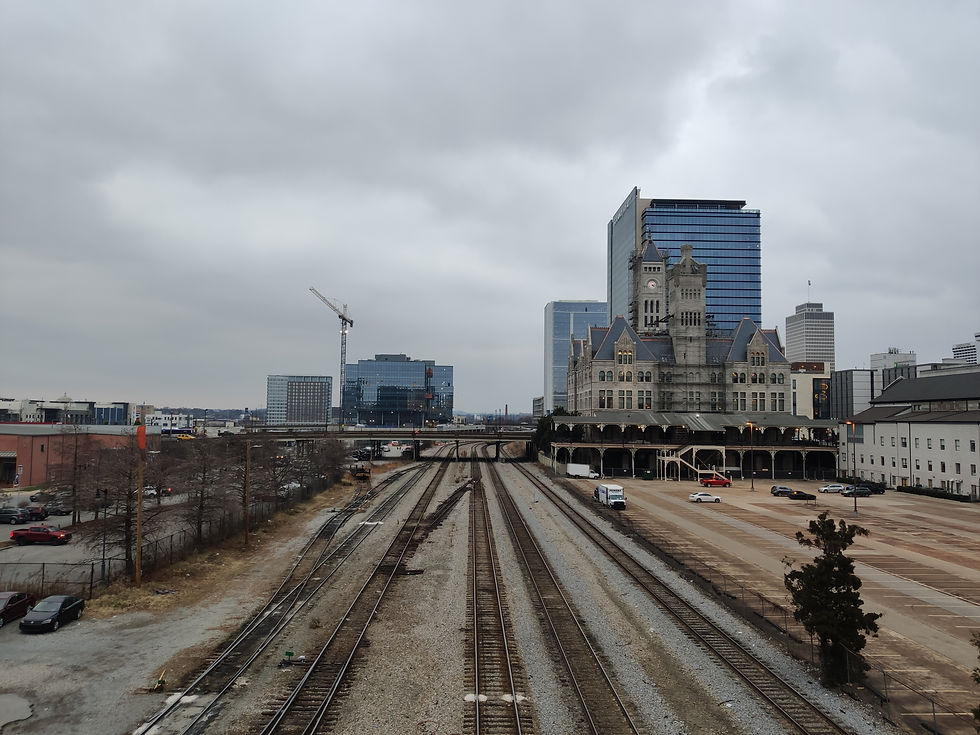
We continued downtown, which was kicking into the weekend mood. There were country music venues (“honky-tonks”) lining the streets and party buses driving around, one of which was just a decommissioned Army truck. We tried shopping for hats, but found them all too expensive or over the top (who knew that a Stetson cost $300 or more?). The largest shop had a very nice salesman with an almost unintelligible accent who started asking me about the Red Sox, whose shirt I was wearing. When I made it clear that I knew nothing about them, he tried discussing the Huskies, which were apparently the University of Connecticut’s football team (“is that hockey?”), after I said we went to school in Connecticut. We were a lost cause.
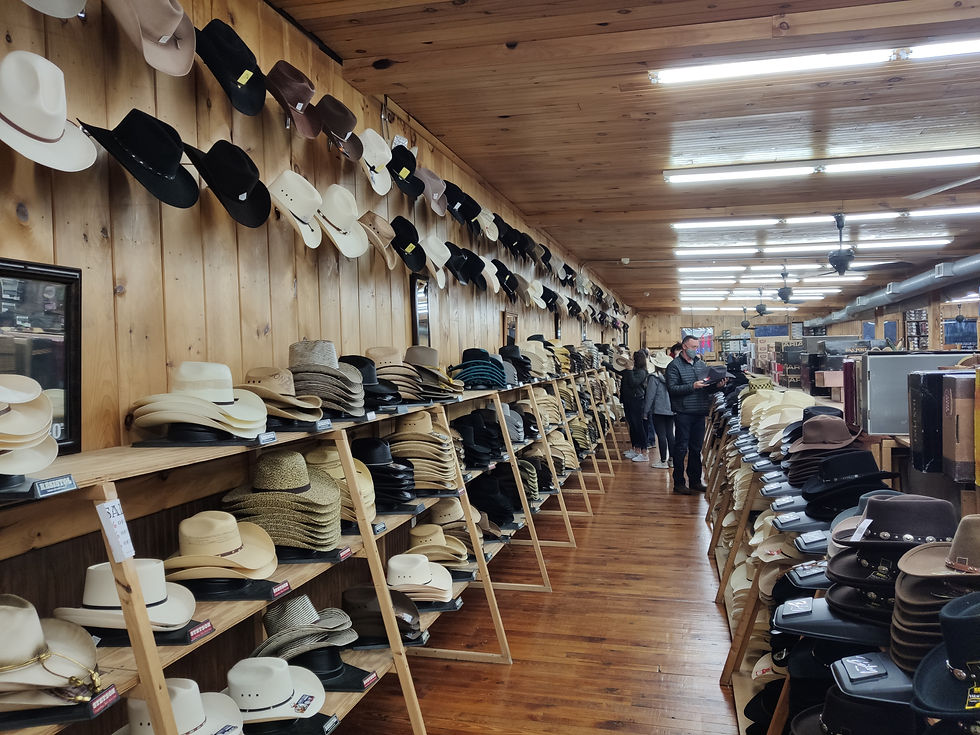
Right off the main drag was a police cordon surrounding the block blown up by a terrorist on Christmas, still a disaster scene of twisted metal and broken glass over two weeks later.
Dinner was at a Thai place where I had some of the spiciest food I can remember (it was a nice break from Southern barbeque, though), after which we returned downtown in search of a honky-tonk. Unfortunately, most of them consider themselves bars, making them off-limits for the underaged members of our party. It was a very strange feeling to not be able to go to a bar - probably for the first time since 2016 - but at least the signs saying that “dancing is absolutely forbidden” were amusing. We finally found a place that was happy to let us in and enjoyed a performance by a country band from New York’s Hudson Valley, which the singer claimed had “more hillbillies than the entire great state of Tennessee”. Having spent four months there last year, she might actually be right, but New York doesn’t have country music playing from its electrical switchboxes.
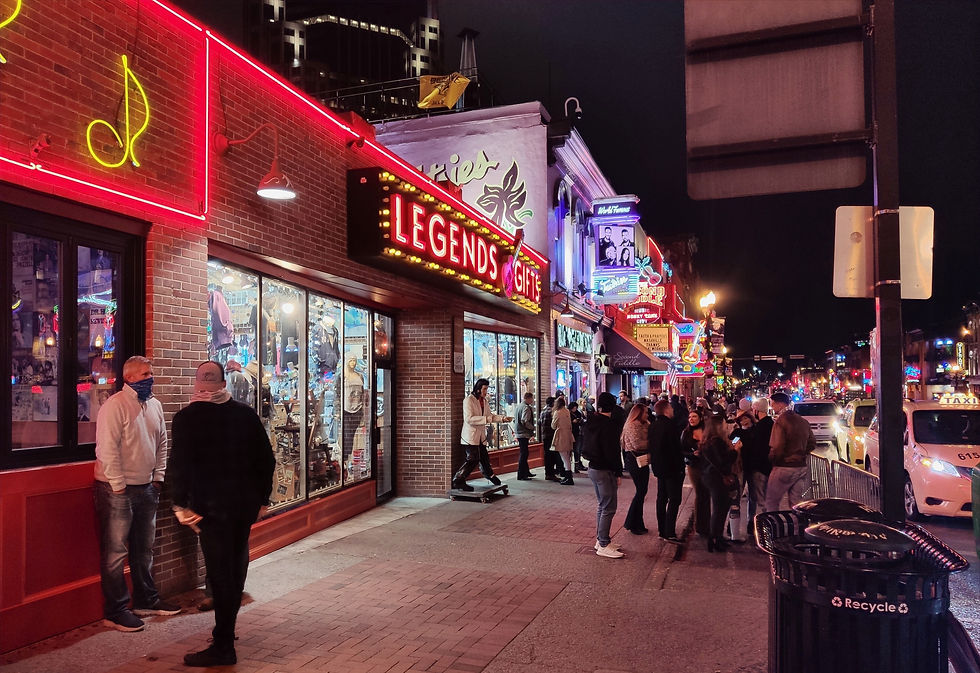
A Visit to "Whiskey Country"
The next morning, we went for a walk around Vanderbilt University’s campus while Richard was busy working. Between an internship and a Hillel program, he was taking so many calls that he had earned himself the nickname “the CEO of phone”. Having failed to ride scooters back from town the previous night (apparently the marginal benefit of drunk people paying to ride back home does not exceed the marginal cost of drunk people riding electric scooters), we found some to take us there. The ride was incredibly cold, to the point where my gloved fingers went numb and my wars started throbbing, but the campus was beautiful. One of the buildings was a near exact replica of one of the new colleges at Yale, which meant that our architecture was copied (try to spot which is which; source for the Yale image).
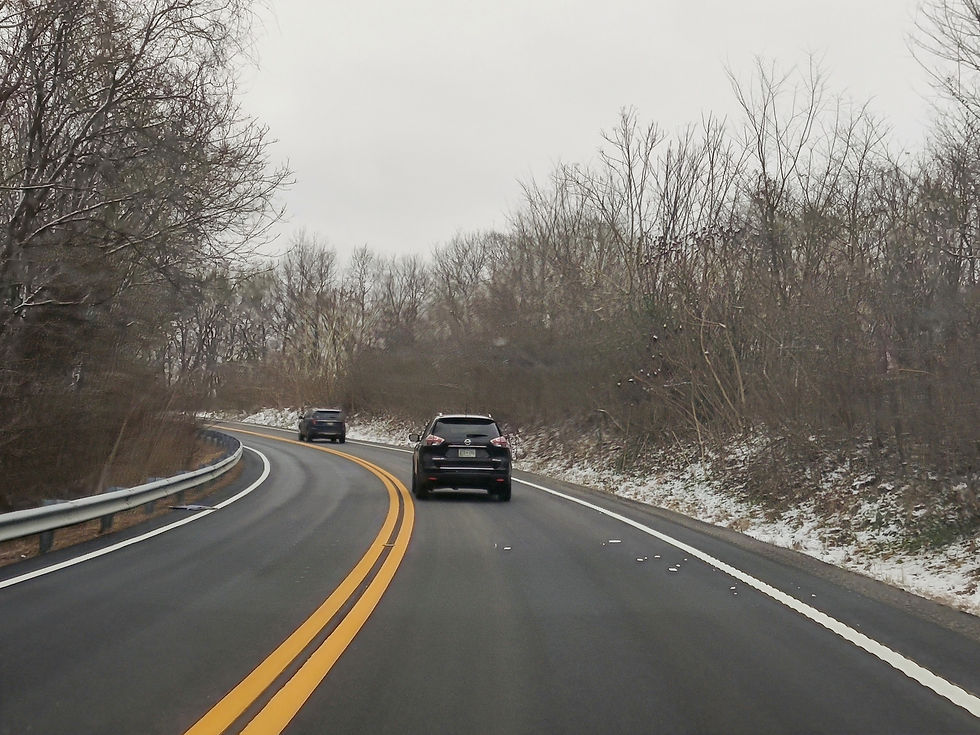
The CEO of Phone finally picked us up and we hit the road south after brunch at an Indian place which for some reason didn’t serve half its normal fare on the weekend. We departed the interstate and started driving west into “Whiskey Country”, which is just code for “rural, undeveloped central Tennessee”. Rising above the snow line several times was very pretty, but the descents returned us to the same grim brown hills. We arrived in Lynchburg and had a fantastic tour of the Jack Daniel distillery, which amazingly still produces every single bottle of Jack in the world. I say amazingly because I have found or drank No. 7 in some really remote parts of the world. Our tour guide sported another incredible accent, but still pegged us as Yalies due to Akeel’s mask. It was only at the end of the tour that I finally realized that he was actually talking about "whiskey stills”, not “whiskey steels”, which I thought was some Tennessee term I had never heard.
The EV chargers at the distillery didn’t work, forcing us to make a beeline to the Alabama state line instead of visiting a sinkhole that had been on the plan. This was truly depressing country, the grey skies complementing the withered plants and the ramshackle houses. Crossing into Alabama eliminated any remaining topography and made the trucks even bigger than they already were. We stopped to charge in the town of Athens and ducked into a fried chicken place for a snack. Richard had warned me that “sweet tea” in Alabama had incredible ammounts of sugar in it but I decided to try it anyhow. I had no idea that water was capable of dissolving so much sugar; the stuff was utterly undrinkable and ended up in the poor plants.
We arrived in Huntsville, where we would be spending the night, and had dinner at a local brewery located next to an axe-throwing place. Arriving back at the hotel, Richard demonstrated his signature driving move - the 17-point turn - earning him cheers from the neighbors when he finally made it into the parking spot.
Huntsville: Megachurch Sunday and a Whitewashed Nazi
The next day was Sunday, so being in the Bible Belt we decided to go to church. Not just any church, but the local campus of the Church of the Highlands, a 16-branch Alabama megachurch with an average weekly attendance of 52,000, making it the second-largest church in the U.S. Everything about this place was insane. First off, the church looked more like an airport terminal or a basketball arena. There was even a coffee shop in the entrance.
The main hall was full to capacity, so we were directed to the “youth growth center”, where we were promised “the same live stream” as the main hall.
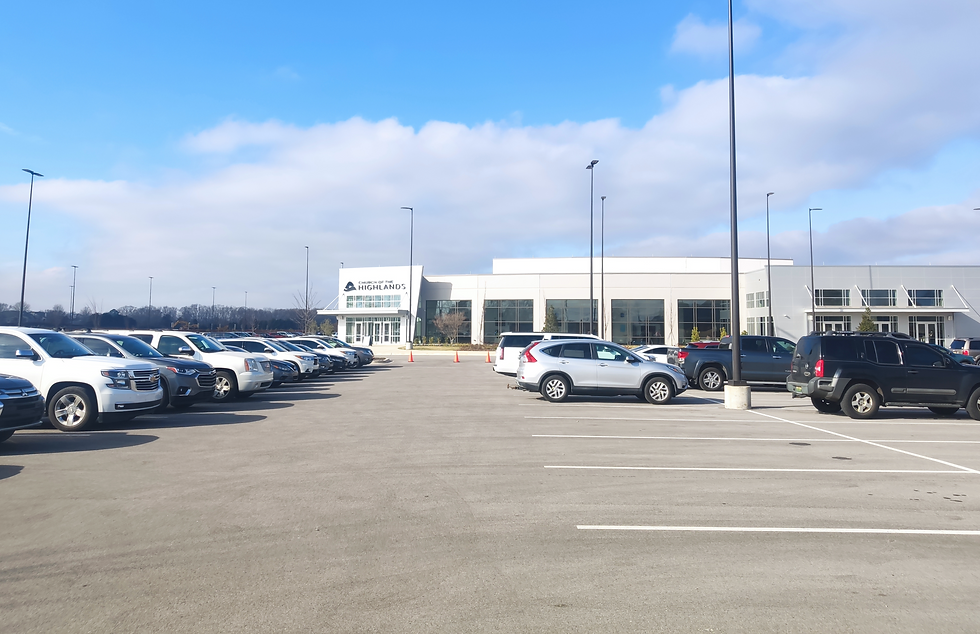
We were handed “Pastoral Care Update” forms to fill out and took our seats in front of a large TV brodcasting the pastor in the main hall. After a few minutes, the stream shifted to some extremely high-quality video sequences with plenty of racial diversity and no mention of the divine, just community.
The senior pastor then took the stage in Birmingham and gave an incredibly suave 40-minute speech without taking as much as a second to think at any point. Starting off with a special blessing to “all our members in the Alabama Department of Corrections”, I was blown away by his charisma. The speech was infused with plenty of ribs at other denominations - mainly Baptists and Pentacostals - whose teachings were “simply not true”, which I thought was kind of rich considering his church was non-denominational. Biblical verses popped up on the screen behind him in perfect sequence, and my favorite quote was “Jesus dedicated a steady place of quiet and it wasn’t the government. Can I get an Amen?” He got that Amen. I later found out there had been a movement to cancel him online after he had liked content by Turning Point USA on Twitter (read this for an idea of the controversy).
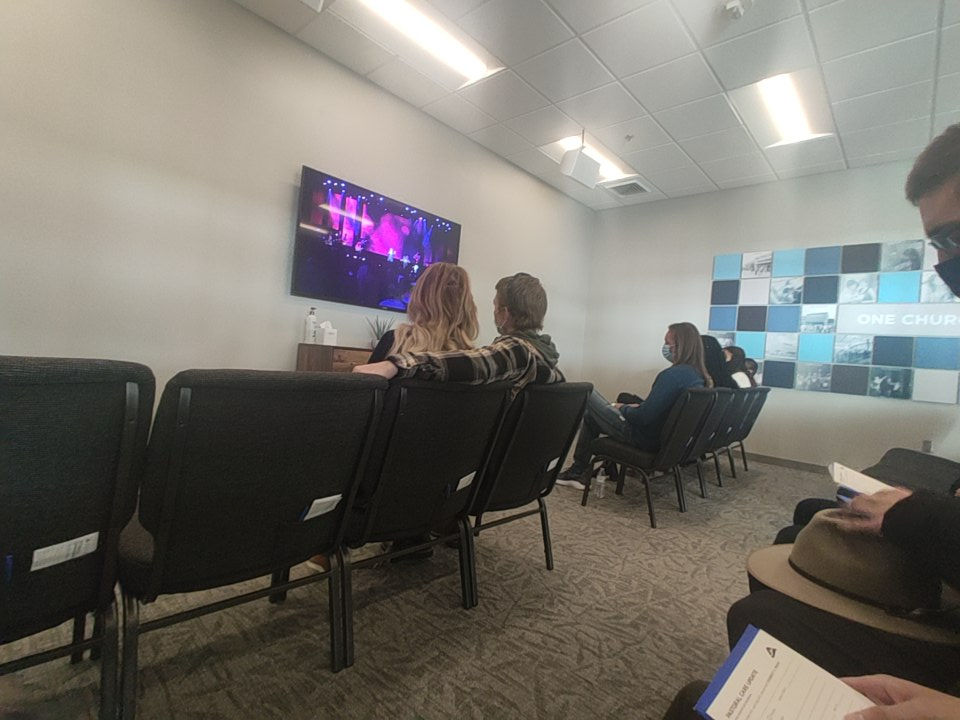
Huntsville was the seat of the U.S. Space and Rocket Center, which we visited after church. It was strange to see a Saturn V and a Space Shuttle rising out of the trees on the outskirts of town, but the museum was a great time and made me feel like I was back at the Smithsonian Air & Space Museum, just with more rednecks. Half the place was practically a shrine to Wernher von Braun, the Nazi rocket scientist turned mastermind of the U.S. early space program, but the word "Nazi" did not appear as much as a single time.


Birmingham: Post-Industrial Civil Rights
We headed south on the interstate through forests that suddenly became green again until arriving in Birmingham. The city bore a remarkable resemblance to its English namesake, with plenty of grim brick architecture, rail lines running through the downtown, and smokestacks belching fumes in the not-so-far distance. We visited the Vulcan, a huge statue of the Roman god of metallurgy by the same name overlooking the city, which had apparently won a prize at the famous 1904 World’s Fair in St Louis despite being rather disproportionate.

We then headed downtown to Railroad Park, an old marshaling yard converted into an urban park, which Richard characterized as looking like “the High Line in Fallout (a video game taking place in a nuclear wasteland).” He wasn’t wrong. The views were downright dystopian, the attempt at a cute downtown overshadowed by blackened railroad tracks, abandoned warehouses, and brick factories. Birmingham wasn’t just ugly, it felt like an overgrown poor small town. The local campus of the University of Alabama was hideous, the highways had more potholes than pavement, and pizza was delivered in pickup trucks (I wish I were making this up).

After dinner at yet another Southern restaurant downtown, we made a detour to the supercharger around the block, where we discovered a local attraction: the highways. Birmingham, like so many other American cities, is at the intersection of several interstate highways, and as such has horrific interchanges ringing the downtown. This corner of the city, at the intersection of I-20, US-31, and US-280, was particularly bad, with overpasses leading in every direction. Some enterprising soul had had the idea to try and make them more aesthetic by adding colorful LED lights to the sides of them, and to be honest it almost worked. We got a good laugh, and several groups of locals had come for Instagram photoshoots.

Akeel drove us back and almost got us killed by driving on the left like in Sri Lanka, and the next morning we returned downtown for a quick visit to the Civil Rights District. Birmingham obviously has plenty of history with the Civil Rights movement of the 1960s and was the location of Martin Luther King’s arrest and incarceration, and a small area downtown is dedicated to commemorating that history. The museum itself was closed, but we visited Kelly Ingram Park, site of the infamous April 1963 protests that saw children incarcerated en masse and peaceful protesters attacked by policemen with clubs and dogs. It was a sickening site of American history but a very moving one.

We set out of Birmingham on I-22 towards Tupelo, MS. Something I found hilarious in Alabama is that all the highways have large signs proclaiming "another project to Rebuild Alabama", as if the state had just been razed by Sherman's forces. As we drove further north, we first passed fall foliage and then re-entered snow territory. With the snow covering the trees by the highway and the overcast skies, the scenery was anything but how I had pictured Alabama. Right after we crossed the Mississippi state line, it actually started snowing.
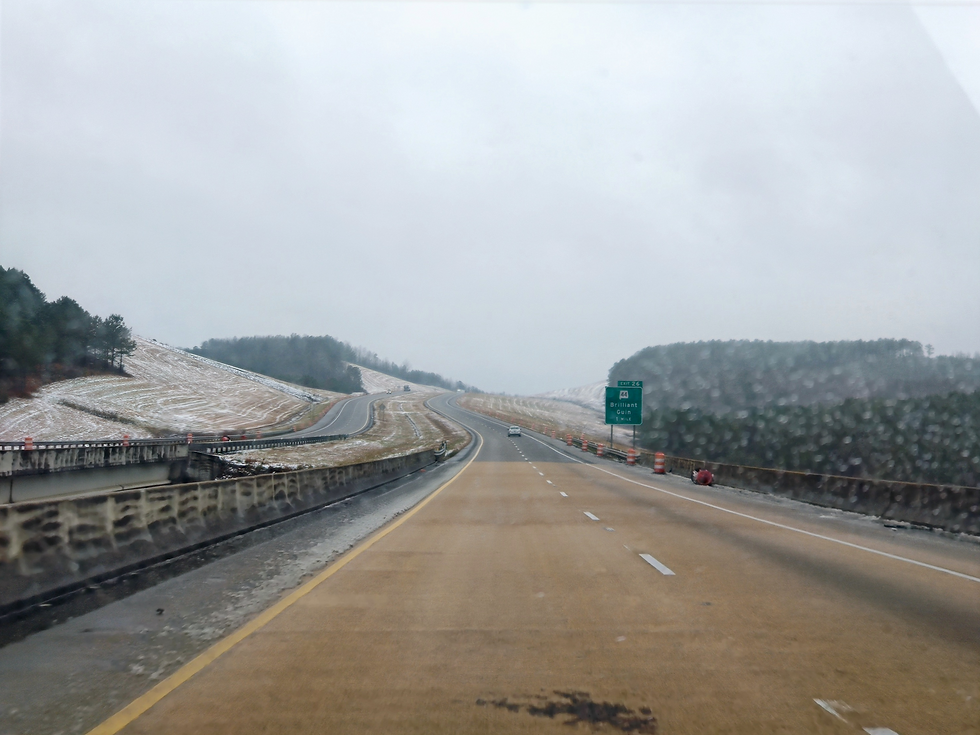
We arrived at a massive mall in Tupelo and tried to reach the Tesla supercharger, but there were huge lines of cars waiting for something and police vehicles blocking the entrances. My first thought was that there had been a shooting, until I saw tents set up in the parking lot and soldiers milling about. We asked a police officer if we could get through to the charger. “You’ve gotta talk to the Army about that.” That didn’t sound reassuring. The soldiers, who were administering COVID vaccines, eventually did let us through after I thanked them for “doing God’s work” and making us circle the entire mall. I thought it was somewhat ironic that the first COVID vaccination location I had seen was in a Mississippi backwater I had previously never heard of.

Memphis: If Beale Street Could Talk, It Wouldn’t
We drove back into the snow towards Memphis. We crossed into Tennessee for the third time in a rather unglamorous fashion, commemorated by a small roadside sign marking the Memphis city limits. The real way to know you’re in Tennessee is by looking for American flags - most of them will have a state flag appended to them ion what I suspect is a minor display of Confederate defiance. North Carolina and Alabama did this with their respective flags, too, but not to the same extent.

We had a minor debacle with our hotel after charging, during which we debated whether we should stay in Germantown, a seemingly kitschy German-style neighborhood east of town, or spend some extra money to stay downtown. We agreed on a hotel near the charger, but when we showed up the receptionist couldn’t find our reservation. A cursory look at my phone revealed that we had booked a room at a different hotel by the same name, located 10 miles further out of town, and a room in this place was almost 50% more. I canceled the reservation and quickly made another at a different place with reasonable ratings.
We drove halfway around the city to the new place, located literally down the block from Graceland, the famous home of Elvis. The neighborhood might have been nice when Elvis bought a house there, but it sure had gone through some transformations since. The area somehow managed to combine the worst aspects of both suburban strip malls and inner-city projects, and the hotel’s kitschy country music decor, guitar-shaped pool, and bizzare Las Vegas mural weren’t helping.
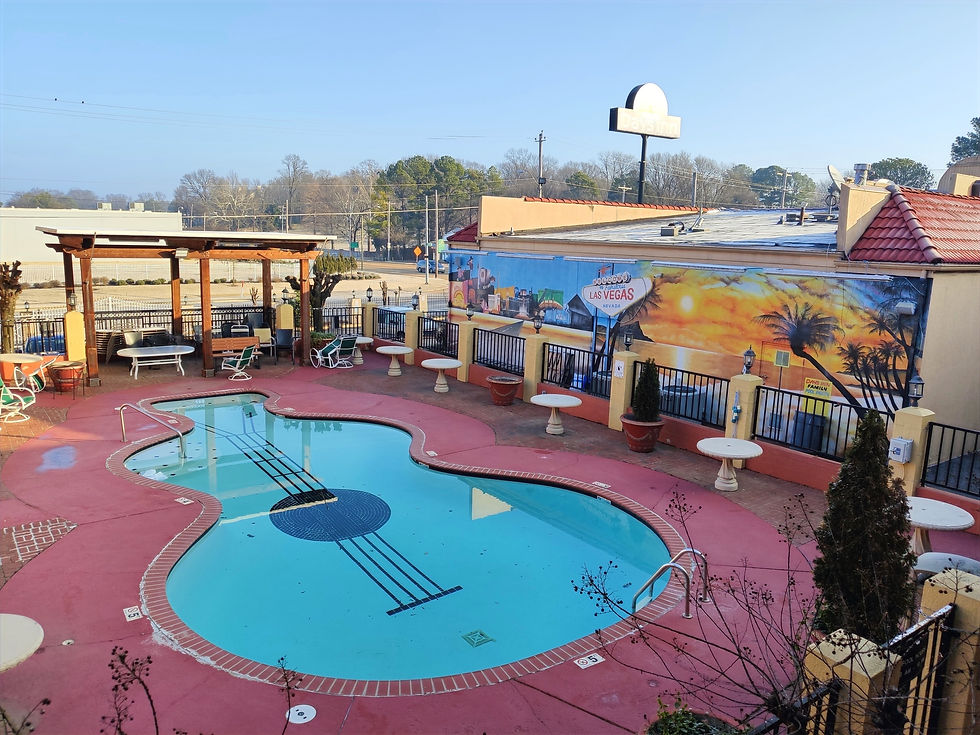
Our room was designated as non-smoking but reeked of cigarette smoke. The receptionist checked us into a different one, which smelled only marginally better, the reduced smell of smoke complemented by a miusty scent of unknown origin. We spent no time dropping our things and returning to the car to see the city. After Graceland, Memphis’ next-biggest attraction is much more eclectic. Downtown, right by the shores of the Mississippi River is a massive glass pyramid, the ninth-largest pyramid in the world. Built as a sports arena, the trememdnous structure is now nothing else than a Bass Pro Shop, and the interior is more bizarre than I had even expected.
Walking in, we crossed a wooden bridge over a small stream with a sign above us reading “Welcome to Paradise”. There is an indoor lake with fishing boats for sale, an aquarium, several fake ecosystems with stuffed animals (some in poses that seemed to indicate they had just been hunted), and a waterfall behind the elevator, which turned out to be the tallest free-standing one in the country. We passed endless rows of fishing gear - I finally got my hat, and for a fraction of the price of Nashville - and headed upstairs to the hunting section. There were dozens of hunting rifles and crossbows for sale, all of which could be tested at the store’s own in-house ranges on the same floor. It was another place that just screamed “AMERICA” as loud as it could.
Memphis had a chain of fried chicken places that was self-styled “world famous” and dinner there did not disappoint. Everything about the place - from the linoleum to the employees to the collard greens - screamed Black southern culture, and the food itself was fantastic. Our waitress was lamenting the sorry state of the empty pandemic-stricken city and we were about to experience it for ourself. We headed to Beale Street, Memphis’ legedary music and nightlife row, which was all lit up in bright neon like Nashville. There was hardly a soul in sight, apart from the many police officers sitting in their cars and the occasional passer-by who looked as confused as we must have. It was the sorriest sight of the trip thus far.






































Birmingham was founded after the Civil War, and I don't think Sherman was ever in Alabama.
I like how you think Yale's architecture is somehow authentic.